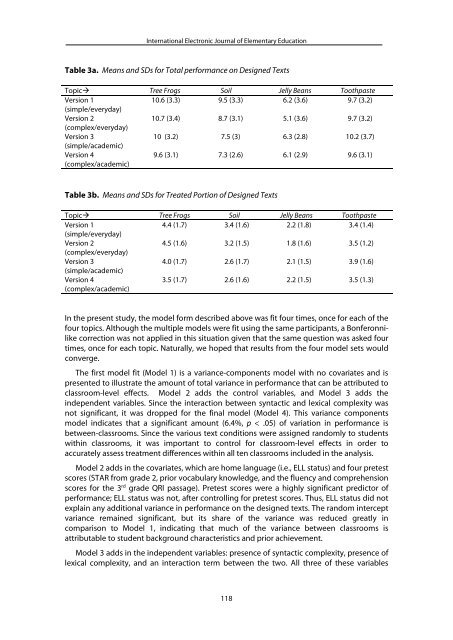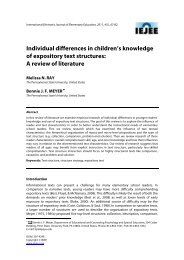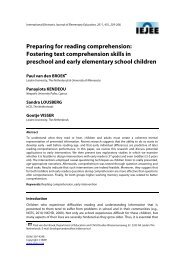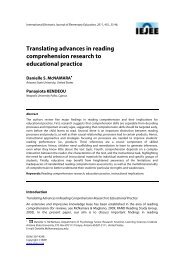Internati<strong>on</strong>al Electr<strong>on</strong>ic Journal <str<strong>on</strong>g>of</str<strong>on</strong>g> Elementary Educati<strong>on</strong>Table 3a. Means <str<strong>on</strong>g>and</str<strong>on</strong>g> SDs for Total performance <strong>on</strong> Designed TextsTopic Tree Frogs Soil Jelly Beans ToothpasteVersi<strong>on</strong> 110.6 (3.3) 9.5 (3.3) 6.2 (3.6) 9.7 (3.2)(simple/everyday)Versi<strong>on</strong> 210.7 (3.4) 8.7 (3.1) 5.1 (3.6) 9.7 (3.2)(complex/everyday)Versi<strong>on</strong> 310 (3.2) 7.5 (3) 6.3 (2.8) 10.2 (3.7)(simple/academic)Versi<strong>on</strong> 4(complex/academic)9.6 (3.1) 7.3 (2.6) 6.1 (2.9) 9.6 (3.1)Table 3b. Means <str<strong>on</strong>g>and</str<strong>on</strong>g> SDs for Treated Porti<strong>on</strong> <str<strong>on</strong>g>of</str<strong>on</strong>g> Designed TextsTopic Tree Frogs Soil Jelly Beans ToothpasteVersi<strong>on</strong> 14.4 (1.7) 3.4 (1.6) 2.2 (1.8) 3.4 (1.4)(simple/everyday)Versi<strong>on</strong> 24.5 (1.6) 3.2 (1.5) 1.8 (1.6) 3.5 (1.2)(complex/everyday)Versi<strong>on</strong> 34.0 (1.7) 2.6 (1.7) 2.1 (1.5) 3.9 (1.6)(simple/academic)Versi<strong>on</strong> 4(complex/academic)3.5 (1.7) 2.6 (1.6) 2.2 (1.5) 3.5 (1.3)In <strong>the</strong> present study, <strong>the</strong> model form described above was fit four times, <strong>on</strong>ce for each <str<strong>on</strong>g>of</str<strong>on</strong>g> <strong>the</strong>four topics. Although <strong>the</strong> multiple models were fit using <strong>the</strong> same participants, a B<strong>on</strong>fer<strong>on</strong>nilikecorrecti<strong>on</strong> was not applied in this situati<strong>on</strong> given that <strong>the</strong> same questi<strong>on</strong> was asked fourtimes, <strong>on</strong>ce for each topic. Naturally, we hoped that results from <strong>the</strong> four model sets wouldc<strong>on</strong>verge.<str<strong>on</strong>g>The</str<strong>on</strong>g> first model fit (Model 1) is a variance-comp<strong>on</strong>ents model with no covariates <str<strong>on</strong>g>and</str<strong>on</strong>g> ispresented to illustrate <strong>the</strong> amount <str<strong>on</strong>g>of</str<strong>on</strong>g> total variance in performance that can be attributed toclassroom-level <str<strong>on</strong>g>effects</str<strong>on</strong>g>. Model 2 adds <strong>the</strong> c<strong>on</strong>trol variables, <str<strong>on</strong>g>and</str<strong>on</strong>g> Model 3 adds <strong>the</strong>independent variables. Since <strong>the</strong> interacti<strong>on</strong> between <str<strong>on</strong>g>syntactic</str<strong>on</strong>g> <str<strong>on</strong>g>and</str<strong>on</strong>g> <str<strong>on</strong>g>lexical</str<strong>on</strong>g> <str<strong>on</strong>g>complexity</str<strong>on</strong>g> wasnot significant, it was dropped for <strong>the</strong> final model (Model 4). This variance comp<strong>on</strong>entsmodel indicates that a significant amount (6.4%, p < .05) <str<strong>on</strong>g>of</str<strong>on</strong>g> variati<strong>on</strong> in performance isbetween-classrooms. Since <strong>the</strong> various text c<strong>on</strong>diti<strong>on</strong>s were assigned r<str<strong>on</strong>g>and</str<strong>on</strong>g>omly to studentswithin classrooms, it was important to c<strong>on</strong>trol for classroom-level <str<strong>on</strong>g>effects</str<strong>on</strong>g> in order toaccurately assess treatment differences within all ten classrooms included in <strong>the</strong> analysis.Model 2 adds in <strong>the</strong> covariates, which are home language (i.e., ELL status) <str<strong>on</strong>g>and</str<strong>on</strong>g> four pretestscores (STAR from grade 2, prior vocabulary knowledge, <str<strong>on</strong>g>and</str<strong>on</strong>g> <strong>the</strong> fluency <str<strong>on</strong>g>and</str<strong>on</strong>g> comprehensi<strong>on</strong>scores for <strong>the</strong> 3 rd grade QRI passage). Pretest scores were a highly significant predictor <str<strong>on</strong>g>of</str<strong>on</strong>g>performance; ELL status was not, after c<strong>on</strong>trolling for pretest scores. Thus, ELL status did notexplain any additi<strong>on</strong>al variance in performance <strong>on</strong> <strong>the</strong> designed texts. <str<strong>on</strong>g>The</str<strong>on</strong>g> r<str<strong>on</strong>g>and</str<strong>on</strong>g>om interceptvariance remained significant, but its share <str<strong>on</strong>g>of</str<strong>on</strong>g> <strong>the</strong> variance was reduced greatly incomparis<strong>on</strong> to Model 1, indicating that much <str<strong>on</strong>g>of</str<strong>on</strong>g> <strong>the</strong> variance between classrooms isattributable to student background characteristics <str<strong>on</strong>g>and</str<strong>on</strong>g> prior achievement.Model 3 adds in <strong>the</strong> independent variables: presence <str<strong>on</strong>g>of</str<strong>on</strong>g> <str<strong>on</strong>g>syntactic</str<strong>on</strong>g> <str<strong>on</strong>g>complexity</str<strong>on</strong>g>, presence <str<strong>on</strong>g>of</str<strong>on</strong>g><str<strong>on</strong>g>lexical</str<strong>on</strong>g> <str<strong>on</strong>g>complexity</str<strong>on</strong>g>, <str<strong>on</strong>g>and</str<strong>on</strong>g> an interacti<strong>on</strong> term between <strong>the</strong> two. All three <str<strong>on</strong>g>of</str<strong>on</strong>g> <strong>the</strong>se variables118
<str<strong>on</strong>g>The</str<strong>on</strong>g> Effects <str<strong>on</strong>g>of</str<strong>on</strong>g> Syntactic <str<strong>on</strong>g>and</str<strong>on</strong>g> Lexical / Arya, Hiebert & Pears<strong>on</strong>were n<strong>on</strong>-significant. We <strong>the</strong>n dropped <strong>the</strong> interacti<strong>on</strong> term from <strong>the</strong> model, leaving model4, in which <str<strong>on</strong>g>lexical</str<strong>on</strong>g> <str<strong>on</strong>g>complexity</str<strong>on</strong>g> affected performance but <str<strong>on</strong>g>syntactic</str<strong>on</strong>g> <str<strong>on</strong>g>complexity</str<strong>on</strong>g> did not.Model 4 explains a significant amount <str<strong>on</strong>g>of</str<strong>on</strong>g> variance for <strong>on</strong>ly two <str<strong>on</strong>g>of</str<strong>on</strong>g> <strong>the</strong> four topics, TreeFrogs <str<strong>on</strong>g>and</str<strong>on</strong>g> Soil. Similar results were not obtained for Jelly Beans <str<strong>on</strong>g>and</str<strong>on</strong>g> Toothpaste; for <strong>the</strong> lattertwo topics, nei<strong>the</strong>r <str<strong>on</strong>g>lexical</str<strong>on</strong>g> nor <str<strong>on</strong>g>syntactic</str<strong>on</strong>g> <str<strong>on</strong>g>complexity</str<strong>on</strong>g> affected performance.This final model suggests that high <str<strong>on</strong>g>lexical</str<strong>on</strong>g> <str<strong>on</strong>g>complexity</str<strong>on</strong>g> (i.e., more low frequency words) in<strong>the</strong> text is associated with lower performance <strong>on</strong> <strong>the</strong> test (p < .05). As would be predicted by<strong>the</strong> design <str<strong>on</strong>g>of</str<strong>on</strong>g> <strong>the</strong> passages, <strong>the</strong> impact <str<strong>on</strong>g>of</str<strong>on</strong>g> <str<strong>on</strong>g>lexical</str<strong>on</strong>g> <str<strong>on</strong>g>complexity</str<strong>on</strong>g> was limited to items in <strong>the</strong>middle 50% <str<strong>on</strong>g>of</str<strong>on</strong>g> <strong>the</strong> passage (<strong>the</strong> manipulated porti<strong>on</strong>s); <str<strong>on</strong>g>lexical</str<strong>on</strong>g> <str<strong>on</strong>g>complexity</str<strong>on</strong>g> did not explainany significant porti<strong>on</strong> <str<strong>on</strong>g>of</str<strong>on</strong>g> variance in resp<strong>on</strong>ses for comprehensi<strong>on</strong> items relating to <strong>the</strong> first<str<strong>on</strong>g>and</str<strong>on</strong>g> final secti<strong>on</strong>s <str<strong>on</strong>g>of</str<strong>on</strong>g> <strong>the</strong> texts. A model with <strong>on</strong>ly <str<strong>on</strong>g>syntactic</str<strong>on</strong>g> <str<strong>on</strong>g>complexity</str<strong>on</strong>g> as a predictor variablewas also fit to <strong>the</strong> data, but was not significant at <strong>the</strong> 0.05 level. Model 4, with <str<strong>on</strong>g>lexical</str<strong>on</strong>g><str<strong>on</strong>g>complexity</str<strong>on</strong>g> predicting comprehensi<strong>on</strong> differences across forms, is presented in Table 4 for allfour topics.<str<strong>on</strong>g>The</str<strong>on</strong>g>se inc<strong>on</strong>sistent results prompted a series <str<strong>on</strong>g>of</str<strong>on</strong>g> post-hoc investigati<strong>on</strong>s into <strong>the</strong> particularc<strong>on</strong>diti<strong>on</strong>s under which <str<strong>on</strong>g>lexical</str<strong>on</strong>g> <str<strong>on</strong>g>complexity</str<strong>on</strong>g> <str<strong>on</strong>g>of</str<strong>on</strong>g> a text may affect comprehensi<strong>on</strong> <str<strong>on</strong>g>of</str<strong>on</strong>g> that text.<str<strong>on</strong>g>The</str<strong>on</strong>g> most obvious c<str<strong>on</strong>g>and</str<strong>on</strong>g>idate to explain <strong>the</strong> inc<strong>on</strong>sistent patterns is background knowledge<str<strong>on</strong>g>of</str<strong>on</strong>g> particular c<strong>on</strong>cepts across <strong>the</strong> four topics. <str<strong>on</strong>g>The</str<strong>on</strong>g> knowledge <str<strong>on</strong>g>of</str<strong>on</strong>g> c<strong>on</strong>cepts explanati<strong>on</strong> wasexplored in two ways. <str<strong>on</strong>g>The</str<strong>on</strong>g> first was an examinati<strong>on</strong> <str<strong>on</strong>g>of</str<strong>on</strong>g> <strong>the</strong> SFI indices <str<strong>on</strong>g>of</str<strong>on</strong>g> frequency from <strong>the</strong>Zeno et al.’s (1995) corpus; <strong>the</strong>se data appear in Table 2. Differences between <strong>the</strong> SFIs for <strong>the</strong>academic <str<strong>on</strong>g>and</str<strong>on</strong>g> everyday versi<strong>on</strong>s <str<strong>on</strong>g>of</str<strong>on</strong>g> <strong>the</strong> texts for <strong>the</strong> four topics were calculated. <str<strong>on</strong>g>The</str<strong>on</strong>g>observed average SFI differences between levels <str<strong>on</strong>g>of</str<strong>on</strong>g> <str<strong>on</strong>g>lexical</str<strong>on</strong>g> <str<strong>on</strong>g>complexity</str<strong>on</strong>g>, which were (in order<str<strong>on</strong>g>of</str<strong>on</strong>g> magnitude), Jelly Beans: 19.5; Toothpaste: 16.8; Soil: 14.7; <str<strong>on</strong>g>and</str<strong>on</strong>g> Tree Frogs: 13.8, would havepredicted <strong>the</strong> greatest between-versi<strong>on</strong> differences in comprehensi<strong>on</strong> <strong>on</strong> <strong>the</strong> Jelly beans <str<strong>on</strong>g>and</str<strong>on</strong>g>Toothpaste passages. Ir<strong>on</strong>ically, just <strong>the</strong> opposite pattern was evident in <strong>the</strong> data, with <strong>the</strong>greatest differences between academic <str<strong>on</strong>g>and</str<strong>on</strong>g> everyday versi<strong>on</strong>s <strong>on</strong> Soil <str<strong>on</strong>g>and</str<strong>on</strong>g> Tree Frogs, <strong>the</strong> twotopics with <strong>the</strong> smallest differences between <strong>the</strong> everyday <str<strong>on</strong>g>and</str<strong>on</strong>g> academic versi<strong>on</strong>s. Thus, SFIindex does not provide a suitable explanati<strong>on</strong> for <strong>the</strong> apparent interacti<strong>on</strong> between topic<str<strong>on</strong>g>and</str<strong>on</strong>g> <str<strong>on</strong>g>lexical</str<strong>on</strong>g> <str<strong>on</strong>g>complexity</str<strong>on</strong>g>.<str<strong>on</strong>g>The</str<strong>on</strong>g> sec<strong>on</strong>d way in which background knowledge was c<strong>on</strong>sidered was to examine <strong>the</strong>relati<strong>on</strong>ship <str<strong>on</strong>g>of</str<strong>on</strong>g> <strong>the</strong> prior knowledge vocabulary measure to comprehensi<strong>on</strong> <str<strong>on</strong>g>of</str<strong>on</strong>g> <strong>the</strong> topics.Recall that <strong>the</strong> prior knowledge vocabulary measure correlated str<strong>on</strong>gly with students’comprehensi<strong>on</strong> <str<strong>on</strong>g>of</str<strong>on</strong>g> <strong>the</strong> manipulated porti<strong>on</strong>s <str<strong>on</strong>g>of</str<strong>on</strong>g> <strong>the</strong> texts: Tree Frogs: .52; Soil: .59; Jelly Beans:.65; toothpaste: .67 (p < .01). <str<strong>on</strong>g>The</str<strong>on</strong>g> mean scores (out <str<strong>on</strong>g>of</str<strong>on</strong>g> a maximum <str<strong>on</strong>g>of</str<strong>on</strong>g> 4) <str<strong>on</strong>g>and</str<strong>on</strong>g> st<str<strong>on</strong>g>and</str<strong>on</strong>g>arddeviati<strong>on</strong>s <str<strong>on</strong>g>of</str<strong>on</strong>g> <strong>the</strong> prior vocabulary assessment items for <strong>the</strong> four topics are as follows: TreeFrogs: 2.3 (sd, 1.3); Soil: 1.7 (sd, 1.3); Jelly Beans: 2.9 (sd, 1.1); Toothpaste: 2.8 (sd, 1.0). When <strong>the</strong>simple <str<strong>on</strong>g>effects</str<strong>on</strong>g> were calculated across <strong>the</strong>se four means, <strong>the</strong> analysis showed that “academicvocabulary” used to create <strong>the</strong> complex versi<strong>on</strong>s <str<strong>on</strong>g>of</str<strong>on</strong>g> <strong>the</strong> passages yielded significantlydifferent pre-test vocabulary results across <strong>the</strong> four topics. <str<strong>on</strong>g>The</str<strong>on</strong>g> pre-test academic vocabularyperformances for Toothpaste <str<strong>on</strong>g>and</str<strong>on</strong>g> Jelly Beans, which did not differ from <strong>on</strong>e ano<strong>the</strong>r, weresignificantly easier than ei<strong>the</strong>r Soil or Tree Frogs; additi<strong>on</strong>ally, Tree Frogs was easier than Soil (p< .01, in all cases); in sum: (Jelly Beans= Toothpaste) > (Tree Frogs > Soil). Thus, <strong>the</strong> empiricalmeasure <str<strong>on</strong>g>of</str<strong>on</strong>g> students’ prior knowledge <str<strong>on</strong>g>of</str<strong>on</strong>g> words was a more accurate predictor <str<strong>on</strong>g>of</str<strong>on</strong>g> <str<strong>on</strong>g>lexical</str<strong>on</strong>g><str<strong>on</strong>g>complexity</str<strong>on</strong>g> than <strong>the</strong> SFI index. It is <strong>the</strong> <strong>on</strong>ly plausible explanati<strong>on</strong> <str<strong>on</strong>g>of</str<strong>on</strong>g> <strong>the</strong> differential effect <str<strong>on</strong>g>of</str<strong>on</strong>g><str<strong>on</strong>g>lexical</str<strong>on</strong>g> <str<strong>on</strong>g>complexity</str<strong>on</strong>g> across topics.Discussi<strong>on</strong><str<strong>on</strong>g>The</str<strong>on</strong>g> present study was designed to address <strong>the</strong> questi<strong>on</strong> <str<strong>on</strong>g>of</str<strong>on</strong>g> whe<strong>the</strong>r <str<strong>on</strong>g>lexical</str<strong>on</strong>g> or <str<strong>on</strong>g>syntactic</str<strong>on</strong>g>factors exert greater influence <strong>on</strong> <strong>the</strong> comprehensi<strong>on</strong> <str<strong>on</strong>g>of</str<strong>on</strong>g> elementary science texts. Based <strong>on</strong>119





